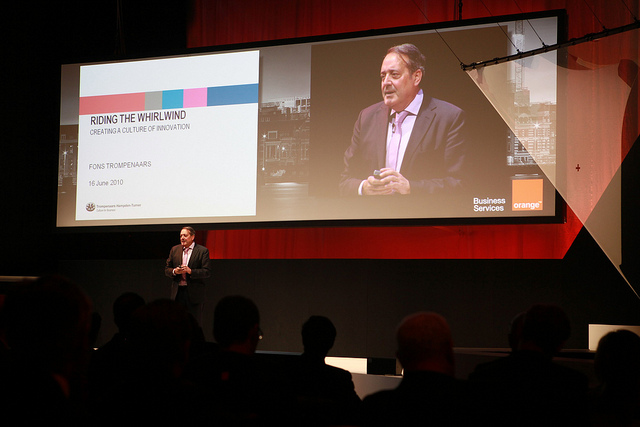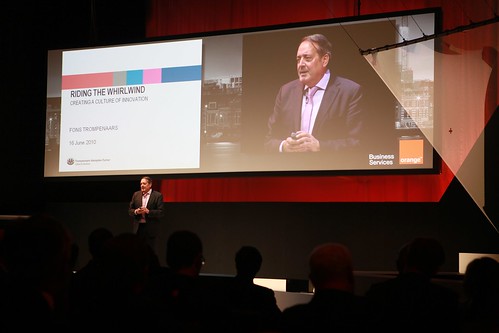Sometimes it takes a night’s sleep to digest a talk. Fons Trompenaars session yesterday here at Orange Live 10 was one such talk. It provoked a huge deal of discussion and argument in the Blogger’s room afterwards, and with a title like “riding the whirlwind, creating a culture of innovation,” it’s probably not hard to see why, especially as he packed 5 book’s worth of thinking into one session.
“We’ve developed bi-polar thinking” Fons declared, before running through a series of examples of the polar opposites and apparent contradictions that businesses find themselves challenged by daily (interjected by a steady stream of jokes at the expense of MBAs of course). The most obvious dilemma is the age old “centralising versus decentralising.”
We’re riding the wave of decentralisation right now, supporting increasingly distributed organisations, but Fons pointed out that the only reason for a business to centralise is that it was decentralised in the first place, otherwise there would be nothing to centralise. If you follow. Is the body centralised or distributed? “yes” said Fons, with the finesse of a seasoned business consultant, or as a scientist might put it “I think you’ll find it’s a bit more complicated than that.”
Now, from my perspective, I think ‘distance’ is being steadily eroded by technology – many of the traditional reasons for centralising are being mitigated by presence, social computing, mobile technology and increasingly high bandwidth. I think distributed will be with us for quite a while to come.
Fon’s thesis is that innovation is the art of combining these contradictory ideas (like central versus distributed) that are apparently contradictory and turning them into concrete and measurable actions, to realise tangible business benefits. That’s quite a challenge, but this integration of opposites has a process to it:
- Recognize – increase awareness.
- Respect – appreciate the cultural differences.
- Reconcile – resolve those cultural differences.
The concept is built on a model of culture – a dynamic process of solving human problems and dilemmas – and the assumption that as humans we are loaded with values that are “half killed by our culture”. What we do and what we want to do are rarely the same. Fons made liberal use of cultural stereo types to illustrate that we live in a world that is more culturally diverse than we realise. Increasing international travel and population mobility has made us more aware of those differences. The themes across the bulk of innovation literature, which Fons outlined, are these: Inclusion, Diversity and Leadership – and a particular type of leadership at that.
“Successful leaders have the competence to help organizations and their teams reconcile dilemmas for better sustainable business performances.”
One lens through which to view an organisation is a classic 2×2 grid, with the axises being:
- Hierarchical versus egalitarian.
- Person-orientated versus task-orientated.
Its a model we’re already familiar with, but what was interesting to me is that these four quadrants lead to four distinct styles of employee motivation:
- MBS – management by subjection – the boss is the boss.
- MBO – management by objective – things to do are the things that matter.
- MBJD – management by job description – the role defines the individual.
- MBP – management by passion – the vision drives the action.
Businesses don’t live out their whole lives in one quadrant, the transitions between the quadrants are the crises that define distinct phases of a business. They key is to understand what sort of business you are in, and tool up appropriately. Finally, back to that culture of innovation, how do you build it?
- Start with the creative individual.
- Build the inventive team.
- Create the innovative organisation.
There. Simple. It’s always the implementation that’s the challenge isn’t it? Fons gave us a word for it – “xnovation” – partnering with people outside of your industry, and learning from business models outside of your industry. Reminds me of the Medici effect. More learning happening here on the Orange Business Live Blog…


